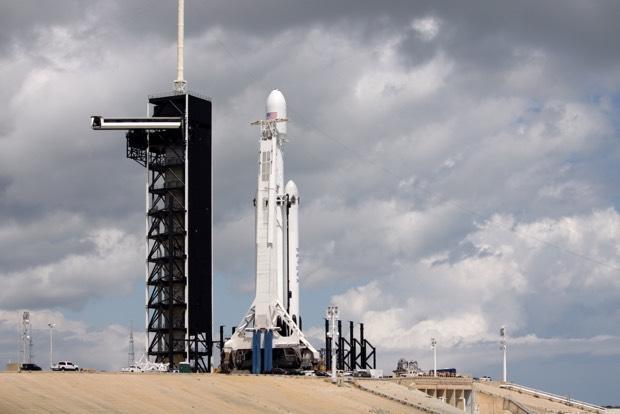A year after launching a Tesla roadster into deep space, a second SpaceX Falcon Heavy rocket was hauled to the pad and erected Wednesday, setting the stage for an early evening launch to boost a heavyweight Saudi communications satellite into orbit. While putting the Arabsat 6A communications station into orbit was the primary goal of the 34-minute mission, SpaceX engineers hoped to recover the rocket's three Falcon 9 core stages for refurbishment and re-use.
The two outboard boosters were expected to attempt dramatic side-by-side landings back at the Cape Canaveral Air Force Station while the central core stage headed for touchdown on an off-shore drone ship.
How to watch the SpaceX Falcon Heavy launch
- What: Launch of SpaceX Falcon Heavy rocket
- Payload: Arabsat 6A communications satellite
- Location: Pad 39A at the Kennedy Space Center in Florida
- Date: Wednesday, April 10, 2019
- Time: 6:35 p.m. EDT – scheduled earliest launch window
The Falcon Heavy, featuring 27 engines in three Falcon 9 core stages, was mounted atop historic pad 39A at the Kennedy Space Center Wednesday morning. Liftoff on the company's fourth flight this year was targeted for 6:35 p.m. EDT, the opening of a one-hour 58-minute window. Forecasters predicted an 80 percent chance of acceptable weather.Live stream: Watch the launch on CBSN and in the video player at the top of this page.
Trending News
Generating more than five million pounds of thrust at liftoff, the Falcon Heavy is the most powerful operational rocket in the world. For its maiden flight in February 2018, the rocket carried a dummy payload, the Tesla Roadster sports car with a spacesuited-mannequin — Starman — strapped into the driver's seat.
But for its second flight, it was strictly business. The rocket was purchased to launch the Arabsat 6A communications station for the Saudi-based Arabsat consortium of Arab states. The Arabsat 6A satellite was built by Lockheed Martin to provide television, radio, mobile and broadband services across the Middle East, Europe and Africa.
In a departure from past designs, the satellite features thin, flexible solar arrays instead of the rigid panels used on other spacecraft. The new multi-mission arrays are 30 percent lighter than more traditional panels but can generate up to 50 percent more power, or 20 kilowatts for Arabsat 6A.
If all goes well, the satellite will be released into an elliptical orbit 24 minutes after liftoff. On-board thrusters will be used from that point to put the craft in the required circular orbit 22,300 miles above the equator where communications stations circle in lockstep with Earth's rotation.
https://www.cbsnews.com/news/spacex-falcon-heavy-launch-window-times-how-to-watch-live-stream-online-today-2019-04-10/
2019-04-10 17:24:00Z
52780262899980

Tidak ada komentar:
Posting Komentar